When Art Gets Complicated: Thoughts From 18 Creatives
“Tell me about when art has been difficult or complicated for your mental health, rather than solely beneficial.”
I work with artists/writers/creatives to help them understand the relationship of health to creativity in their own lives in order to achieve holistic wellness and success.
We are not all "tortured geniuses" and art isn't always therapy - both things can be true but most of where art meets psychology is in the rich magical middle of those two experiences. That middle is what Create Me Free is all about.
And so, one of the things that I ask people about in interviews is, “how has art harmed/hindered/triggered you?” Or, phrased another way, “tell me about when art has been difficult or complicated for your mental health, rather than solely beneficial.”
Today I have six direct responses to that from interviews I did previously with other creatives. And following that, I have a roundup of related quotes /links from the Substack world.
From
:“In acting, we learn how to delve deep to get into character. Thing is, we often don’t learn how to come back up for air once we’re done. Since the beginning of my rigorous training experience, I’ve had to work through ways of doing this myself, without harm.”
Read Jenn’s complete interview:
From
:“I'm doggedly determined to create a finished product and will work at my art until I can bring it into something solid--even words. This is not always healthy as I'm given to extremely long hours, exhaustion. I'm a solitary person, who prefers my own company and the characters who live inside my mind and tend to be introverted. Writing is painful--especially writing narratives. It causes the writer to re-experience the feelings associated with the event she's describing. I always do somatic work to release trauma after and during writing sessions.”
Read Story Carrier’s complete interview:
From
:“I would say it does cause me overwhelm and anxiety for feeling like I need to be good enough, artistic enough, talented enough, worthy enough, etc. I second guess my expression a lot so that it's likable and desirable for others and when it's not sometimes I don't value it and look for a lot of validation. I guess I feel like it's super trendy to be any type of artist right now. There are so many people out here doing and be artists, which is great but I often feel jealous or competitive and like there isn't room for me and that causes me pain.
I'm not always sure what role art should play in my life and if it always has to be the same role all the time. I also want others to value art more and generally being creative and receiving the benefits. I try to convince people that it can be beneficial, and we all have creative abilities, but some people just don't see it. I'm not always sure if I should convince or if I have the right to convince. I also have felt pressure from others that there are certain rules you are supposed to follow to be perceived as a good artist and this really messes with me sometimes.”
Read Ruthie’s full interview:
From
:“Sometimes as I'm writing I get into a kind of zone where three hours seem to go by in thirty minutes. Other times I weep as I write and must stop to allow feelings to work themselves out. I can't say whether it's my writing process or the degree to which I identify with my characters that brings these moments about. … Sometimes art disturbs. That's not necessarily a bad thing; if we can't understand what troubles us, we can't overcome it, or get through it, or deal with it effectively.”
Read Robin’s full interview:
From Leon:
“Occasionally, I've suffered a slump after a particularly harrowing article, but that's fine because my unique selling point is that I'll go to the places others won't for the sake of writing. If I didn't push myself so hard I'd feel like a fraud.”
Read Leon’s full interview:
From
:“I think some years ago my relationship with art turned from symbiotic to parasitic. I don't really know the exact date it happened, but most of the benefit I used to get from expressing myself started to leech energy from me instead of giving me energy. I don't think I properly understood that until I got on medication, and now it's a lot harder to make art without wondering if it will take from me instead of being nourishing. This is the biggest fear I have because until now I have only been able to notice it in retrospect. However, I think it starts by being able to feel your energy. Are the same actions that used to fill you up now draining you? Do you find your mental state deteriorating even though not much has changed in your life? Do you find yourself taking care of your work at the expense of your own mental state? Do you find yourself constantly doubting yourself, or feeling that you can only create if somebody validates you through your art? Do you find yourself envious of other creators instead of inspired by them? This is an imperfect list, of course, but those are some of the ways I could see trying to determine if you have a parasitic relationship with your art. A lot of it is the same as noticing any parasitic relationship in your life. Honestly, a lot of people have never had a healthy relationship with their art, or haven't in a long, long time. So, you might read those questions and say "I don't understand. That's how I art" to which I would ask if you think any of that is healthy. I want to grow with my art and have it feed me, not drain me. Otherwise, I'll just go sell soup or something that doesn't require so much of my soul to do it. I have been doing this too long to be drained my by work. I have a finite amount of energy in any day, and I want to give it to the things that nurture my energy, not drain it.”
Read Russell’s full interview:
From around the Substackverse …
These are all excerpts I’ve shared previously in “Art + Psychology” Link Love roundups that relate to the idea that sometimes art can harm/hinder/be complicated!
Andrew Smith of Goatfury Writes shared Solomon Shereshevsky
a journalist who remembered everything, was studied psychologically because of that, and performed as a mnemonist but at a cost to his mental health and wellbeing. He had a form of synesthesia that I found described as:
“fivefold synaesthesia, in which the stimulation of one of his senses produced a reaction in every other. For example, if Shereshevskii heard a musical tone played he would immediately see a colour, touch would trigger a taste sensation, and so on for each of the senses. The images that his synaesthesia produced usually aided him in memorizing.”
Andrew explains the problem:
“this wasn’t a tap he could turn off or a switch that could be flipped off.
Shereshevsky was stuck with vivid recall, and faced with an overwhelming amount of information coming in. This came at a significant cost to his daily life and psychological well-being.
Imagine never being able to forget anything. Not only would painful memories persist for your entire life, but every little trivial event in your life would crowd your thoughts, often making it difficult to concentrate on the present. This was S’s life.
Even worse, synesthesia saw to it that S would have a hard time dealing with routine daily tasks. A simple conversation could trigger a cascade of colors, tastes, and tactile sensations. This constant sensory overload made ordinary interactions and tasks unexpectedly challenging and exhausting.”
We all have unique minds and I find that cases like this one of extremely unique minds show us how complex it all is - a trait can be both a gift and a curse, it can help as well as harm.
Feasts and Fables of shared in their newsletter
some terrific creative lessons learned from taking a course and I love that the list of lessons begins with:
“Putting myself into a learning environment means I think more about my writing. This feels good. Putting myself into a learning environment means I overthink my writing. This does not feel good.”
I think whenever we stretch ourselves, we may come up against these challenges and tensions where it feels good and not good for a variety of reasons. I think sometimes those of us going through a hard mental health time can get lost in the not good part. But if we can focus on finding the balance where the good exists, remembering that feeling “not good” isn’t always a bad thing, then our stretching can be positive.
Wendy MacNaughton of Wendy MacNaughton shared in Doodle Finale
some “drawing fitness tips”
“A few of you expressed that you’ve been experiencing hand cramps and some physical discomfort while drawing. UGH. I’m sorry. That sucks. Every drawer has been there.
Quick tips for drawing health:
When you draw, sit up straight with both feet on the ground. (Take it from the person in PT for a busted hip due to sitting with one foot up on her drafting chair for years.)”
Visit her post for more of those tips. I mention it here because, of course, all health is both mental and physical. But also because I’ve interviewed people who have expressed to me that because of their mental health symptoms, they sometimes create compulsively, leading to physical damage to their bodies in various forms. So, whether you just need to stretch a little because you write/draw/play/whatever too long in one sitting or you’re at that other end of the more compulsive spectrum, remember to stay in touch with your body.
In my book, Crochet Saved My Life, I included an appendix that offers hand exercises for crocheters, which I also find useful as a writer. For example, here is a simple one for the fingers:
“Place both of your pinkie fingers on the edge of a table. Press down on the table with your pinkie fingers, gently raising and lowering your hands a few times. Repeat for each of your other fingers.”
Caroline Rothstein wrote Legends Never Die for Narratively
for paying subscribers which is absolutely worth paying for if you’re familiar with the movie Kids. Kids was a pivotal movie for me, and it was so interesting to read the back story behind it and what’s happened to some of the people since then. Including the ways in which being in the film catapulted some of them to amazing acting careers (Chloe Sevigny, Rosario Dawson) and took others to death (suicide, overdose) …
“Ronald says towards the end, Harold was preoccupied with how fame and notoriety affected him. “It’s like a sponge that won’t expand even if you soak it in water,” he says. It wasn’t just partying. His life didn’t only belong to him. Isn’t that what we always do to celebrities? “He was insecure. And he was jealous,” says Priscilla. “And he struggled just like everybody struggles with emotions. Sometimes he handled it well, and sometimes he did not handle it so well. He was a human, he was definitely not a saint. I think that's important.” Jefferson, Priscilla, Ronald, and others who knew Harold, switch between past and present tense when talking about him, as if he’s still here, as if no one will ever say goodbye.”
Fame, whether celebrity level or local or social media, is complicated and it can cause/exacerbate challenges in our lives.
Peter Smetanick of Peter's Scribbles shared An Impromptu Interview
And wrote about Sam:
“As a young boy it started with ADHD medication, then he began abusing Ritalin, then in community college he turned to Adderall and finally Dexedrine. All of these drugs seemed to help him focus and advance his art tremendously.
Initially Sam’s work consisted of very intricate pen drawings until a friend asked him to paint the side of his truck. Sam admitted to not knowing how to paint, but offered to try it anyway. He fell in love with it. But it wasn’t long before Sam’s drug use caught up to him. In college he had turned to speed, excessive amounts of speed. Sam believes this is what led to his first mental break and resulting schizophrenia diagnosis.
Sam admits it hasn’t been an easy road, something I can certainly relate to. He always thought that he needed the drugs to produce good work. For years he struggled with his mental illness and put his art aside.”
Complicated. Mental health symptoms lead to medications which improve focus and enhance creative output but then become problematic and stopping the medication makes one feel like they can’t create … and eventually they figure out that they can, maybe … this stuff is complicated. And this is the complex interaction between art and mental health that interests me - because the more we can dig into it, the more we might be able to make meaning out of all of it.
of wrote Regret & Satisfaction
which explores the truth of how challenging a creative small business can get at this time of year, when many makers make the most of their money because of holiday sales.
“October was a pressure month and I’ve felt like a machine. Automating my work, repeating tasks. My right shoulder was sore for a week after attaching handles non-stop for 3 days. Even though I generally make the same quantity of ceramic wares year round, the selling part is more compressed and I roughly make half of my yearly income in 3 months which is amazing and scary! It’s a lot of eggs in one basket. If I could choose otherwise, I would.”
Makers may often feel complex feelings at this time of year. We are grateful for the sales that come from doing the work that we love. We are inspired by the community around us who wants to purchase what we make to give to others as gifts because that is really special. We are also tired and may feel conflicted about consumerism and so many other things. It’s complicated. And Julie’s post captures that in a variety of ways.
Winston of Coffee Times shared The ebb and flow of friendship
“Writers and creative individuals, in particular, are often caught in the whirlwind of their art. As we pour our energy into our craft, we may inadvertently neglect the essential task of keeping in touch with friends. The commitment to our writing can lead to isolation, even though the very essence of our creative pursuits stems from the complexities of human experiences.
Having fewer friends is not inherently negative, but it can lead to a sense of loneliness or emptiness if not tackled properly. As the number of friends decreases, individuals may find themselves yearning for the easy camaraderie they once had. Loneliness can affect mental and emotional well-being, highlighting the importance of maintaining meaningful connections throughout life.”
This can be a kind of chicken and egg thing, right? Many people who already feel lonely (left out/ isolated/ different/ socially uncomfortable/ whatever it might be) turn to art and writing as a source of solace, comfort, connection, healing … but then over-focusing on the relationship with creativity can limit the person’s desire/ability/energy to go out and make real life friends. Often, the longer we remain isolated with our art, the harder it is to initiate change in terms of creating relationships with other humans. And so then the art itself becomes a crutch, a hindrance. The art can also be how we do connect to community, though. Chicken and egg can be a positive spiral as well.
Victoria K. Walker of Beyond Bloomsbury wrote about Gwen John
who is an artist I didn’t know anything about before reading this. Victoria’s work is always focused on the art, not the mental health, but she writes so poetically about the artists that I always want to learn more about that, and, because of my specific niche interests, I always find myself looking for clues to their mental health as it relates to their art. In this piece, I noticed:
“Rodin was thirty-five years her senior, but he and Gwen became lovers, and their passionate affair lasted ten years, with Gwen writing thousands of letters to him, sometimes three times a day. …
Though Rodin cared deeply for her, he found her powerful emotions unsettling and eventually ended the affair. Broken-hearted, she found solace not only in her art but also in religion.”
So, at first glance, this suggests art was healing for her, but perhaps it was more complciated than that. At the first mention of being Rodin’s lover, my attention perked up, because he’s also famously linked with Camille Claudel, an artist with a complex mental health history, and arguably his treatment of her exacerbated many of her symptoms. I also found myself intrigued by Victoria’s description of the end of John’s short life, a death by illness-induced starvation in her mid-thirties. I’ve only had the chance to do a little bit more digging about the artist’s mental health but what I’ve found so far that I intend to explore further:
From the National Library of Wales: “During this period, encouraged by Rodin, Gwen John made a self-conscious return to painting and during which she created some of her best-known images whilst at the same time battling with depression and sporadic illness.”
From Christian Kile of Thoughts on Art: “Without political diversions or manifestos, she knew her works were significant, and labored hard for them; perhaps she thought the personal cost too much and stopped her production early. Regardless of the cause, her self-imposed exile from the London scene and turn to Catholicism contributed to a body of work with an understated quietude. She reflected that for her, art came before children; who, she said, is remembered by history simply for becoming a mother?”
And most curious: a memoir of Letters to Gwen John by Celia Paul who was the lover of Lucian Freud, grandson of Sigmund Freud …
Mary Hutto Fruchter of Mary’s Pocketful of Prose wrote Bypassing the Jugular
Which digs into a question that a lot of people have about writing memoirs (and about putting the self directly into other art at times). She talks about the line between sharing your authentic truth and feeling like you have to share it all, all the gory details, even when that’s not necessarily the right thing for you to do.
“The jugular veins are major blood vessels that direct blood from your head to your heart. If your jugular is cut, do you know what happens? —You die. You die a violent, awful death. Even going for the metaphorical jugular means to harm someone in a cruel way. Is that what I want for my writing life? I don’t think so. I think I would prefer that my jugular and the jugulars of the people I write about, especially because most of them are people I care about, remain intact. …
I want to tell a multi-faceted story, a story that offers hope. In telling my story, the story that belongs to me and is mine alone to tell, there may be some things I choose to leave out. I get to do this because it is my story, and I am a human being who breathes, loves and has feelings, and some things cut too close to the jugular. I don’t think I have to bleed myself out to write a story that’s both authentic and valuable to others.”
This is a great reminder that creating art has the potential to retraumatize you and it has the potential to cause harm to others in various ways when you tell their stories alongside your own. That doesn’t mean that we should stop telling those stories. It simply means that it’s okay to ask yourself what stories you’re ready to tell in what way right now and let that be enough.
Nadja de Oliveira of Musings in Writing shared in Kindred Notes
“I remember having just turned 13, having written three pages in a little notebook, and someone in my family asked if they could read it. They were just curious, but it was then that a paralysing fear came over me. What if someone knew my desires and fears? What if they mocked me for it? What if I just didn’t want someone to know some things about myself? What if they used my secrets against me? And it was then I stopped writing in my little notebook.
I am glad the fear has dissipated. In a way, I see it as an act of rebellion to write down my feelings, because of my past fear. An act of defiance. It has grown to mean so much to me, to my day, to my state of mind.”
In this case, the art itself isn’t harmful, but the reaction to the art created harm, and that stunted the creative process for a long time. I’m glad for Nadja that this has shifted now. And I can relate to the violation … my father (who to his dying breath would emphatically state that he did not believe in boundaries) would read my private writing when I was a kid sometimes and it deeply affected me. The funny thing is that I’m not sure it’s something I ever consciously processed or worked through - probably because there was so much other nonsense to process and work through - but reflecting back on it now I realize that there’s no emotional charge for me around it anymore, which is a nice thing to realize.
Becoming a Photographer Because of My Mom, and Despite Her by Dina Litovsky of In the Flash
is a powerful story of how complicated art-as-a-career can be in some families. In part:
“Mom instantly encouraged this, and I spent all my childhood hearing her praise and imagining myself as a future painter. She supported everything — I took painting classes, spent a year in an art school, and was a staff artist with my high school magazine. I wrote decent poetry. I took ballet. So, it was to my great surprise that when I declared my plan to major in painting and art history at NYU, mom suddenly put her foot down. "Pre-med or law," she said. "Art is a hobby, not a profession."
I felt somewhat cheated, but believed that mom had my best interest in mind, and so I put myself through a psychology degree and four years of pre-med. As graduation loomed closer, a dark void would swoop in, crippling me with anxiety. I took the MCATs with the same excitement as if I were committing myself to prison. Then came my birthday. Just as I was about to send out medical school application, mom gifted me my first digital camera, immaculately wrapped with a bow (mom was a professional at giving presents). The rest, as they say, is history.
First, however, came the Dark Ages. As an unemployed photographer, I lived with my parents throughout my 20s, and many evenings I overheard them discuss what a disappointment I turned out to be. Mom would lament all the hard work and effort she put into me. She regretted encouraging my various art hobbies and partly blamed herself for my failure. My parents were so embarrassed by my new career choice, that they encouraged me to lie to my 86-year-old grandmother because they were afraid the truth would literally kill her. For five years, I spun stories about my non-existent medical school experiences, and when my grandmother died, she was proud of me for becoming a doctor.”
Cody Cook-Parrott of Monday Monday wrote Marketing in a Broken World
which has a lot to say about being exhausted right now that I think resonates for many of us. And this:
“Perhaps this is just what it is like to be a big feeler, to be highly sensitive, to be neurodiverse. War wages on and I find it can feel so embarrassing to say - Oh the world is a mess, take my little quilt class! Oh the world is a mess? Come to my little co working group!
I am reminded, time and time again, that this is actually where deep and revolutionary work happens. When we gather we are saying fuck you to capitalism and yes to making blankets for the sake of blanket making. We are saying fuck you to war taking away our desire for creative practice. When you market your offerings you are not saying that you don’t see the world, but that the world keeps on turning and the work keeps on needing to be worked.
We don’t carry on business as usual, because we can use our offerings to point the direction of our attention toward our values and what matters to us the most. And yet business must carry on. We labor and we work and we fight for what we believe in and they don’t have to be separate.”
Keep making. Keep being. Keep trying. And rest when you’re exhausted so that you can keep going.
And let’s wrap up with a return to Russell Nohelty, who I also interviewed as excerpted earlier. Rae Katz of Inner Workings Interviewed Russell Nohelty about living with chronic illness
And as usual everything in the interview is valuable. There’s a great section about choosing “beige living” (outside the extremes) but for our purposes here today I wanted to highlight:
“I hate positivity culture. The biggest problem with positivity culture is that they think there's an answer. Do you know how little we know about the human body? We are very good at dealing with about twenty diseases, and there are a billion diseases where the answer is: we're going to try medication with you until you give up or we find one that works. We don't know why it works. I think the toxic part of positivity culture is the idea that you can change the outcome significantly. You might be able to manage the outcome, you might be able to improve the outcome, but almost never can you completely reverse the outcome, and almost never do you even fully understand that it works.”
I highlight this because I’ve seen in some settings that art therapy focuses so much on the healing potential that it glosses over the pain. It jumps straight into “let’s write gratitude lists and figure out how to transform the pain into beauty through art.” And that’s a great place to get to because art is cathartic / therapeutic but there often needs to be space first (and throughout) for just sitting with the pain and not trying to most into a good place with it.
If you read this far, perhaps you liked the work. The work does take work. It only continues with support, so please consider subscribing.




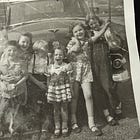
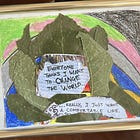
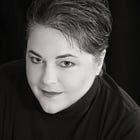
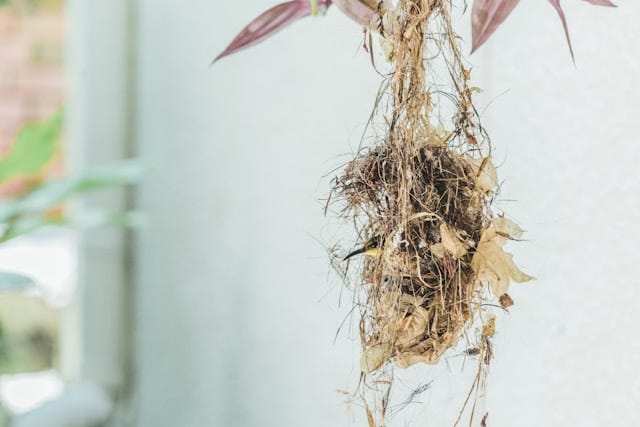
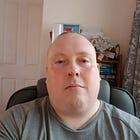



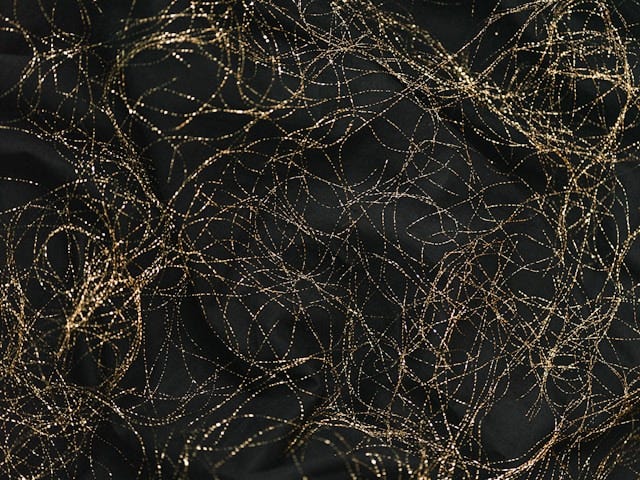
Several of these give me food for thought, particularly Nohelty. He asks a great question: how can our art nourish and not take from us?
Thanks, Kathryn, for letting everyone—especially other writers—have a glimpse into what writing is like for different people. It's fascinating how many similarities there are, and even more fascinating to discover the differences. I once had a writing coach tell me not to write the words "Chapter One" before I had a full outline and some character sketches. That worked for her, and she was a fabulous writer. For me? It was a death knell. The more I think I know about a story before I write it, the harder it is to write. I love a blank page, and my characters tell me what to put on it.